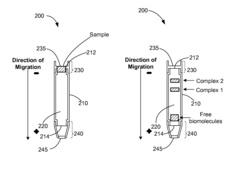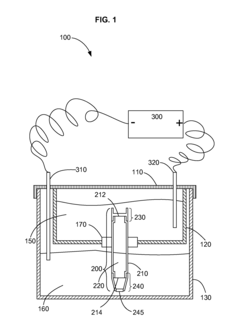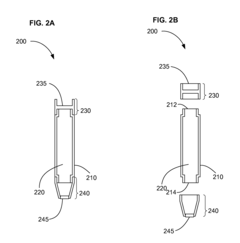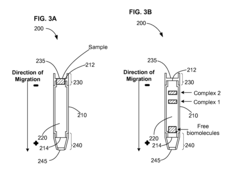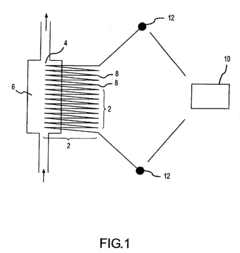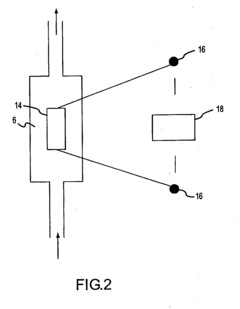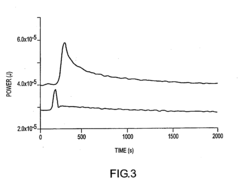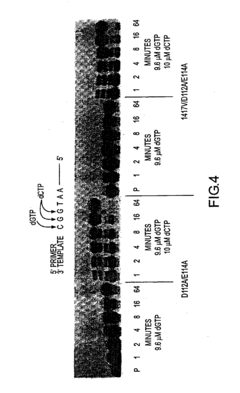How Is Gel Electrophoresis Transforming Genomic Research?
JUN 30, 20259 MIN READ
Generate Your Research Report Instantly with AI Agent
Patsnap Eureka helps you evaluate technical feasibility & market potential.
Gel Electrophoresis Evolution and Research Goals
Gel electrophoresis has been a cornerstone technique in molecular biology since its inception in the 1960s. This method, which separates molecules based on their size and electrical charge, has undergone significant evolution over the decades, transforming genomic research in profound ways. Initially used for protein separation, gel electrophoresis quickly found applications in DNA and RNA analysis, becoming an indispensable tool in the burgeoning field of genomics.
The evolution of gel electrophoresis has been marked by several key milestones. The introduction of agarose gels in the 1970s allowed for better separation of large DNA molecules, while the development of polyacrylamide gels enabled high-resolution separation of smaller DNA fragments and proteins. The advent of pulsed-field gel electrophoresis (PFGE) in the 1980s revolutionized the analysis of large DNA molecules, making it possible to separate chromosomal-sized DNA.
As genomic research has advanced, so too have the goals and applications of gel electrophoresis. Modern research aims to achieve higher resolution, faster separation times, and increased sensitivity. The development of capillary electrophoresis and microfluidic devices has pushed the boundaries of what's possible, allowing for the analysis of ever-smaller sample volumes and enabling high-throughput genomic studies.
One of the primary research goals in gel electrophoresis is to enhance its integration with other genomic technologies. This includes improving compatibility with next-generation sequencing platforms, developing more sensitive detection methods for rare genetic variants, and creating automated systems for rapid, large-scale genomic analysis. Researchers are also focusing on developing environmentally friendly and cost-effective alternatives to traditional gel electrophoresis methods.
In the context of genomic research, gel electrophoresis continues to play a crucial role in various applications. It remains an essential technique for DNA fragment analysis, PCR product verification, and genetic fingerprinting. The technique is also vital in studying gene expression, protein-DNA interactions, and epigenetic modifications. As genomic research delves deeper into understanding complex genetic disorders and personalized medicine, gel electrophoresis is evolving to meet these new challenges.
The future goals of gel electrophoresis in genomic research include developing ultra-high-resolution techniques for single-nucleotide polymorphism (SNP) detection, creating portable devices for point-of-care genetic testing, and integrating artificial intelligence for automated analysis of electrophoresis results. These advancements aim to further transform genomic research by enabling more precise, rapid, and accessible genetic analysis across various fields, from basic research to clinical diagnostics.
The evolution of gel electrophoresis has been marked by several key milestones. The introduction of agarose gels in the 1970s allowed for better separation of large DNA molecules, while the development of polyacrylamide gels enabled high-resolution separation of smaller DNA fragments and proteins. The advent of pulsed-field gel electrophoresis (PFGE) in the 1980s revolutionized the analysis of large DNA molecules, making it possible to separate chromosomal-sized DNA.
As genomic research has advanced, so too have the goals and applications of gel electrophoresis. Modern research aims to achieve higher resolution, faster separation times, and increased sensitivity. The development of capillary electrophoresis and microfluidic devices has pushed the boundaries of what's possible, allowing for the analysis of ever-smaller sample volumes and enabling high-throughput genomic studies.
One of the primary research goals in gel electrophoresis is to enhance its integration with other genomic technologies. This includes improving compatibility with next-generation sequencing platforms, developing more sensitive detection methods for rare genetic variants, and creating automated systems for rapid, large-scale genomic analysis. Researchers are also focusing on developing environmentally friendly and cost-effective alternatives to traditional gel electrophoresis methods.
In the context of genomic research, gel electrophoresis continues to play a crucial role in various applications. It remains an essential technique for DNA fragment analysis, PCR product verification, and genetic fingerprinting. The technique is also vital in studying gene expression, protein-DNA interactions, and epigenetic modifications. As genomic research delves deeper into understanding complex genetic disorders and personalized medicine, gel electrophoresis is evolving to meet these new challenges.
The future goals of gel electrophoresis in genomic research include developing ultra-high-resolution techniques for single-nucleotide polymorphism (SNP) detection, creating portable devices for point-of-care genetic testing, and integrating artificial intelligence for automated analysis of electrophoresis results. These advancements aim to further transform genomic research by enabling more precise, rapid, and accessible genetic analysis across various fields, from basic research to clinical diagnostics.
Genomic Research Market Demand Analysis
The genomic research market has experienced significant growth in recent years, driven by advancements in sequencing technologies and increased focus on personalized medicine. Gel electrophoresis, a fundamental technique in molecular biology, plays a crucial role in this expanding market by enabling the separation and analysis of DNA fragments.
The demand for genomic research tools and services is projected to continue its upward trajectory, with the global market expected to reach substantial value in the coming years. This growth is fueled by various factors, including the rising prevalence of genetic disorders, increasing investments in genomics research, and the growing adoption of personalized medicine approaches.
Gel electrophoresis, as a key component of genomic research, contributes significantly to this market demand. Its applications span across various sectors of genomic research, including gene expression analysis, mutation detection, and DNA fingerprinting. The technique's versatility and reliability make it an indispensable tool for researchers and clinicians alike.
In the pharmaceutical and biotechnology industries, gel electrophoresis is widely used for drug discovery and development processes. The technique aids in identifying potential drug targets, validating gene therapies, and assessing the efficacy of novel treatments. As these industries continue to invest heavily in genomic research, the demand for gel electrophoresis equipment and consumables is expected to rise correspondingly.
Academic and research institutions represent another significant segment driving the demand for gel electrophoresis in genomic research. Universities and research centers worldwide are increasingly focusing on genomics studies, contributing to the overall market growth. The technique's accessibility and cost-effectiveness make it particularly attractive for academic research settings.
The healthcare sector is also a major contributor to the market demand for gel electrophoresis in genomic research. As precision medicine gains traction, there is a growing need for genetic testing and molecular diagnostics. Gel electrophoresis plays a vital role in these applications, enabling the analysis of genetic markers associated with various diseases and conditions.
Emerging trends in genomic research, such as single-cell genomics and epigenetics, are further expanding the applications of gel electrophoresis. These advanced research areas require precise DNA and RNA analysis, driving the demand for more sophisticated gel electrophoresis systems and techniques.
Geographically, North America and Europe currently dominate the market for genomic research tools, including gel electrophoresis. However, the Asia-Pacific region is expected to witness the fastest growth in the coming years, driven by increasing investments in genomics research and rising awareness of personalized medicine approaches.
The demand for genomic research tools and services is projected to continue its upward trajectory, with the global market expected to reach substantial value in the coming years. This growth is fueled by various factors, including the rising prevalence of genetic disorders, increasing investments in genomics research, and the growing adoption of personalized medicine approaches.
Gel electrophoresis, as a key component of genomic research, contributes significantly to this market demand. Its applications span across various sectors of genomic research, including gene expression analysis, mutation detection, and DNA fingerprinting. The technique's versatility and reliability make it an indispensable tool for researchers and clinicians alike.
In the pharmaceutical and biotechnology industries, gel electrophoresis is widely used for drug discovery and development processes. The technique aids in identifying potential drug targets, validating gene therapies, and assessing the efficacy of novel treatments. As these industries continue to invest heavily in genomic research, the demand for gel electrophoresis equipment and consumables is expected to rise correspondingly.
Academic and research institutions represent another significant segment driving the demand for gel electrophoresis in genomic research. Universities and research centers worldwide are increasingly focusing on genomics studies, contributing to the overall market growth. The technique's accessibility and cost-effectiveness make it particularly attractive for academic research settings.
The healthcare sector is also a major contributor to the market demand for gel electrophoresis in genomic research. As precision medicine gains traction, there is a growing need for genetic testing and molecular diagnostics. Gel electrophoresis plays a vital role in these applications, enabling the analysis of genetic markers associated with various diseases and conditions.
Emerging trends in genomic research, such as single-cell genomics and epigenetics, are further expanding the applications of gel electrophoresis. These advanced research areas require precise DNA and RNA analysis, driving the demand for more sophisticated gel electrophoresis systems and techniques.
Geographically, North America and Europe currently dominate the market for genomic research tools, including gel electrophoresis. However, the Asia-Pacific region is expected to witness the fastest growth in the coming years, driven by increasing investments in genomics research and rising awareness of personalized medicine approaches.
Current Gel Electrophoresis Techniques and Challenges
Gel electrophoresis remains a cornerstone technique in genomic research, with current methods continually evolving to meet the demands of modern scientific inquiry. The most widely used techniques include agarose gel electrophoresis for DNA separation and polyacrylamide gel electrophoresis (PAGE) for protein analysis. These methods have been refined over decades, offering improved resolution and sensitivity.
Agarose gel electrophoresis has seen advancements in gel composition and buffer systems, allowing for better separation of DNA fragments across a wide size range. Pulsed-field gel electrophoresis (PFGE) has extended this capability to larger DNA molecules, enabling the analysis of entire chromosomes or large genomic regions.
In protein analysis, 2D-PAGE has become a powerful tool for proteomics, allowing researchers to separate proteins based on both their isoelectric point and molecular weight. This technique has been crucial in identifying and characterizing complex protein mixtures in various biological samples.
Despite these advancements, gel electrophoresis faces several challenges in the context of genomic research. One significant issue is the limited throughput of traditional gel-based methods. As genomic studies increasingly involve large-scale analyses, the time-consuming nature of gel electrophoresis can become a bottleneck in research workflows.
Another challenge is the difficulty in automating gel electrophoresis processes. While some aspects, such as gel imaging and analysis, have been automated, the preparation and loading of samples often still require manual intervention, limiting scalability and introducing potential variability.
The resolution of gel electrophoresis, while improved, still falls short for certain applications in genomic research. For instance, distinguishing between DNA fragments that differ by only a few base pairs or separating proteins with very similar molecular weights remains challenging.
Quantification accuracy is another area of concern. While digital imaging and analysis software have enhanced quantification capabilities, issues such as non-uniform staining and background noise can still affect the precision of results, particularly for low-abundance molecules.
Lastly, the use of potentially hazardous materials, such as ethidium bromide for DNA staining, poses safety and environmental concerns. While safer alternatives have been developed, they often come with trade-offs in sensitivity or cost.
As genomic research continues to advance, addressing these challenges will be crucial for maintaining gel electrophoresis as a relevant and powerful technique in the field. Innovations in gel materials, detection methods, and automation technologies are actively being pursued to overcome these limitations and expand the capabilities of gel electrophoresis in genomic applications.
Agarose gel electrophoresis has seen advancements in gel composition and buffer systems, allowing for better separation of DNA fragments across a wide size range. Pulsed-field gel electrophoresis (PFGE) has extended this capability to larger DNA molecules, enabling the analysis of entire chromosomes or large genomic regions.
In protein analysis, 2D-PAGE has become a powerful tool for proteomics, allowing researchers to separate proteins based on both their isoelectric point and molecular weight. This technique has been crucial in identifying and characterizing complex protein mixtures in various biological samples.
Despite these advancements, gel electrophoresis faces several challenges in the context of genomic research. One significant issue is the limited throughput of traditional gel-based methods. As genomic studies increasingly involve large-scale analyses, the time-consuming nature of gel electrophoresis can become a bottleneck in research workflows.
Another challenge is the difficulty in automating gel electrophoresis processes. While some aspects, such as gel imaging and analysis, have been automated, the preparation and loading of samples often still require manual intervention, limiting scalability and introducing potential variability.
The resolution of gel electrophoresis, while improved, still falls short for certain applications in genomic research. For instance, distinguishing between DNA fragments that differ by only a few base pairs or separating proteins with very similar molecular weights remains challenging.
Quantification accuracy is another area of concern. While digital imaging and analysis software have enhanced quantification capabilities, issues such as non-uniform staining and background noise can still affect the precision of results, particularly for low-abundance molecules.
Lastly, the use of potentially hazardous materials, such as ethidium bromide for DNA staining, poses safety and environmental concerns. While safer alternatives have been developed, they often come with trade-offs in sensitivity or cost.
As genomic research continues to advance, addressing these challenges will be crucial for maintaining gel electrophoresis as a relevant and powerful technique in the field. Innovations in gel materials, detection methods, and automation technologies are actively being pursued to overcome these limitations and expand the capabilities of gel electrophoresis in genomic applications.
Current Gel Electrophoresis Applications in Genomics
01 Gel composition and preparation
Various gel compositions and preparation methods are used in gel electrophoresis. These include specific formulations of agarose or polyacrylamide gels, as well as techniques for creating gradient gels. The composition and preparation of the gel matrix are crucial for achieving optimal separation of biomolecules.- Gel composition and preparation: Various gel compositions and preparation methods are used in gel electrophoresis. These include specific formulations of agarose or polyacrylamide gels, as well as techniques for creating gradient gels. The composition and preparation of the gel matrix are crucial for achieving optimal separation of molecules based on size and charge.
- Electrophoresis apparatus design: Innovations in electrophoresis apparatus design focus on improving efficiency, resolution, and ease of use. These designs may include features such as integrated cooling systems, adjustable voltage controls, and specialized buffer chambers. Some apparatuses are designed for specific applications or to accommodate different gel sizes and configurations.
- Detection and analysis methods: Various detection and analysis methods are employed in gel electrophoresis to visualize and quantify separated molecules. These may include fluorescence-based detection, colorimetric staining, or integration with mass spectrometry. Advanced image analysis software and algorithms are also used to interpret electrophoresis results and provide quantitative data.
- Microfluidic and miniaturized systems: Miniaturized and microfluidic gel electrophoresis systems have been developed to reduce sample volume requirements and increase throughput. These systems often integrate sample preparation, separation, and detection into a single device. They may use novel materials or fabrication techniques to create microscale gel structures or channels for electrophoretic separation.
- Specialized applications and modifications: Gel electrophoresis techniques have been modified and optimized for specialized applications in various fields. These may include adaptations for specific types of biomolecules, such as proteins or nucleic acids, or for particular analytical purposes like DNA sequencing or protein mass determination. Some modifications aim to improve resolution, speed, or compatibility with downstream processes.
02 Electrophoresis apparatus design
Innovations in electrophoresis apparatus design focus on improving efficiency and resolution. These include specialized buffer chambers, electrode configurations, and cooling systems. Advanced designs may incorporate features for automated sample loading or real-time monitoring of the separation process.Expand Specific Solutions03 Detection and analysis methods
Various detection and analysis methods are employed in gel electrophoresis to visualize and quantify separated biomolecules. These include fluorescence-based detection, staining techniques, and advanced imaging systems. Some methods allow for real-time monitoring of the separation process or post-electrophoresis analysis.Expand Specific Solutions04 Sample preparation and loading techniques
Advancements in sample preparation and loading techniques aim to improve the resolution and reproducibility of gel electrophoresis. These include methods for concentrating samples, removing interfering substances, and precise sample application to the gel. Some techniques focus on minimizing sample loss and increasing loading capacity.Expand Specific Solutions05 Specialized electrophoresis applications
Specialized applications of gel electrophoresis have been developed for specific research or diagnostic purposes. These include techniques for separating particular types of biomolecules, such as proteins or nucleic acids, as well as methods for analyzing complex mixtures or detecting specific targets within a sample.Expand Specific Solutions
Key Players in Gel Electrophoresis Industry
Gel electrophoresis is significantly advancing genomic research, with the market experiencing rapid growth due to increasing applications in DNA sequencing and genetic analysis. The technology is in a mature stage but continues to evolve, driven by innovations from key players like Life Technologies Corp., Bionano Genomics, Inc., and EXACT Sciences Corp. These companies are developing more sophisticated systems, improving resolution and throughput. The market is expanding globally, with a growing demand in both research and clinical settings, particularly in cancer diagnostics and personalized medicine. As the technology becomes more accessible and cost-effective, its adoption is expected to accelerate across various sectors of the life sciences industry.
Life Technologies Corp.
Technical Solution: Life Technologies has developed advanced gel electrophoresis systems that are transforming genomic research. Their E-Gel™ system utilizes pre-cast agarose gels with integrated electrodes, significantly reducing preparation time and improving reproducibility[4]. The company has also introduced digital electrophoresis platforms like the iBright™ Imaging Systems, which combine high-resolution gel imaging with automated analysis software. These systems can detect and quantify DNA and RNA with high sensitivity, supporting applications such as next-generation sequencing library preparation and CRISPR genome editing validation[5]. Life Technologies' innovations in gel electrophoresis have streamlined workflows and increased throughput in genomic research laboratories worldwide.
Strengths: User-friendly systems, high reproducibility, integrated analysis software. Weaknesses: Proprietary consumables can be costly, may require initial investment in new equipment.
Bionano Genomics, Inc.
Technical Solution: Bionano Genomics has revolutionized genomic research with their Optical Genome Mapping (OGM) technology, which complements traditional gel electrophoresis. Their Saphyr system uses nanochannel arrays to linearize ultra-long DNA molecules, enabling the detection of large structural variations that are often missed by short-read sequencing technologies[1]. This approach allows for the analysis of genomic elements up to megabases in length, providing a more comprehensive view of genome architecture. The company has demonstrated the utility of their technology in identifying complex structural variations in cancer genomes and rare genetic disorders[2][3].
Strengths: High-resolution mapping of large genomic rearrangements, ability to detect structural variations missed by other technologies. Weaknesses: Higher cost compared to traditional gel electrophoresis, requires specialized equipment and expertise.
Innovative Gel Electrophoresis Methods for Genomic Research
Method for the purification of biological macromolecules
PatentInactiveUS20110011742A1
Innovation
- The method involves loading a sample containing free biomolecules and complexes onto an electrophoresis gel, applying an electric current to separate the free biomolecules from the complexes, and then reversing the current direction to collect the complexes of interest, using a semi-permeable membrane to retain the biomolecules of interest, thus masking inhomogeneity and concentrating them for analysis.
Method of determining the nucleotide sequence of oligonucleotides and DNA molecules
PatentInactiveUS20100209922A1
Innovation
- A novel method called 'reactive sequencing' that detects DNA polymerase-catalyzed incorporation of deoxynucleoside monophosphates individually and serially in a microfluidic system, eliminating the need for electrophoretic separation and using techniques like fluorescence, chemiluminescence, or microcalorimetry for detection, with a two-cycle system involving exonuclease-deficient and proficient enzymes to ensure accuracy.
Bioinformatics Integration with Gel Electrophoresis
The integration of bioinformatics with gel electrophoresis has revolutionized genomic research by enhancing data analysis, interpretation, and visualization capabilities. This synergy has led to more efficient and accurate genomic studies, enabling researchers to extract meaningful insights from complex biological data.
Bioinformatics tools have significantly improved the analysis of gel electrophoresis results. Advanced image processing algorithms can now automatically detect and quantify DNA bands, reducing human error and increasing throughput. These tools can also normalize data across multiple gels, allowing for more reliable comparisons between experiments.
Machine learning algorithms have been developed to interpret gel electrophoresis patterns, enabling the identification of specific genetic markers or mutations. This has proven particularly valuable in fields such as forensics and genetic diagnostics, where rapid and accurate analysis is crucial.
The integration of gel electrophoresis data with other genomic information has created powerful platforms for comprehensive genomic analysis. Researchers can now correlate electrophoresis results with sequence data, gene expression profiles, and structural variations, providing a more holistic view of genetic information.
Bioinformatics has also facilitated the creation of databases that store and share gel electrophoresis data. These repositories allow researchers to compare their results with previously published data, fostering collaboration and accelerating scientific discovery.
Visualization tools have transformed how researchers interact with gel electrophoresis data. Three-dimensional modeling of DNA migration patterns and interactive gel image analysis software have made it easier to identify subtle differences in DNA samples and track genetic variations across populations.
The combination of gel electrophoresis and bioinformatics has enabled high-throughput genomic studies. Automated systems can now process and analyze thousands of samples simultaneously, generating vast amounts of data that can be quickly interpreted using sophisticated bioinformatics algorithms.
In personalized medicine, this integration has improved the detection of genetic markers associated with diseases. Bioinformatics tools can rapidly analyze gel electrophoresis results to identify specific genetic variations, enabling more targeted and effective treatments.
As genomic research continues to advance, the integration of bioinformatics with gel electrophoresis is expected to play an increasingly important role. Future developments may include real-time analysis of electrophoresis data, improved prediction of DNA behavior in gels, and more seamless integration with other genomic technologies.
Bioinformatics tools have significantly improved the analysis of gel electrophoresis results. Advanced image processing algorithms can now automatically detect and quantify DNA bands, reducing human error and increasing throughput. These tools can also normalize data across multiple gels, allowing for more reliable comparisons between experiments.
Machine learning algorithms have been developed to interpret gel electrophoresis patterns, enabling the identification of specific genetic markers or mutations. This has proven particularly valuable in fields such as forensics and genetic diagnostics, where rapid and accurate analysis is crucial.
The integration of gel electrophoresis data with other genomic information has created powerful platforms for comprehensive genomic analysis. Researchers can now correlate electrophoresis results with sequence data, gene expression profiles, and structural variations, providing a more holistic view of genetic information.
Bioinformatics has also facilitated the creation of databases that store and share gel electrophoresis data. These repositories allow researchers to compare their results with previously published data, fostering collaboration and accelerating scientific discovery.
Visualization tools have transformed how researchers interact with gel electrophoresis data. Three-dimensional modeling of DNA migration patterns and interactive gel image analysis software have made it easier to identify subtle differences in DNA samples and track genetic variations across populations.
The combination of gel electrophoresis and bioinformatics has enabled high-throughput genomic studies. Automated systems can now process and analyze thousands of samples simultaneously, generating vast amounts of data that can be quickly interpreted using sophisticated bioinformatics algorithms.
In personalized medicine, this integration has improved the detection of genetic markers associated with diseases. Bioinformatics tools can rapidly analyze gel electrophoresis results to identify specific genetic variations, enabling more targeted and effective treatments.
As genomic research continues to advance, the integration of bioinformatics with gel electrophoresis is expected to play an increasingly important role. Future developments may include real-time analysis of electrophoresis data, improved prediction of DNA behavior in gels, and more seamless integration with other genomic technologies.
Ethical Implications in Genomic Research Technologies
The rapid advancement of gel electrophoresis in genomic research has brought forth significant ethical considerations that demand careful examination. As this technology continues to revolutionize our understanding of genetic information, it raises important questions about privacy, consent, and the potential misuse of genetic data.
One of the primary ethical concerns surrounding gel electrophoresis in genomic research is the issue of informed consent. As researchers gain the ability to extract and analyze increasingly detailed genetic information, it becomes crucial to ensure that individuals fully understand the implications of participating in genetic studies. This includes comprehending the potential risks, benefits, and future uses of their genetic data.
The storage and security of genetic information obtained through gel electrophoresis techniques also present ethical challenges. With the growing volume of genomic data being generated, there is an increased risk of data breaches or unauthorized access. Researchers and institutions must implement robust security measures to protect sensitive genetic information and maintain the trust of study participants.
Another ethical consideration is the potential for discrimination based on genetic information. As gel electrophoresis enables more comprehensive genetic profiling, there is a risk that this information could be used to discriminate against individuals in areas such as employment, insurance, or healthcare. Policymakers and researchers must work together to establish safeguards that prevent the misuse of genetic data while still allowing for scientific progress.
The concept of genetic privacy is also at the forefront of ethical discussions surrounding gel electrophoresis in genomic research. As this technology allows for the identification of specific genetic markers and traits, it raises questions about an individual's right to keep their genetic information private. This becomes particularly complex when considering familial implications, as genetic information can reveal insights not only about the individual but also about their relatives.
Furthermore, the increasing accessibility and affordability of gel electrophoresis techniques have democratized genetic research, leading to ethical concerns about direct-to-consumer genetic testing. While this accessibility can empower individuals with knowledge about their genetic makeup, it also raises questions about the interpretation of results and the potential psychological impact of discovering genetic predispositions to certain conditions.
As gel electrophoresis continues to advance genomic research, it is essential to address these ethical implications proactively. This includes developing comprehensive guidelines for the responsible use of genetic information, establishing clear consent processes, and fostering public dialogue about the ethical dimensions of genomic research. By doing so, we can harness the transformative potential of gel electrophoresis while upholding ethical standards and protecting individual rights.
One of the primary ethical concerns surrounding gel electrophoresis in genomic research is the issue of informed consent. As researchers gain the ability to extract and analyze increasingly detailed genetic information, it becomes crucial to ensure that individuals fully understand the implications of participating in genetic studies. This includes comprehending the potential risks, benefits, and future uses of their genetic data.
The storage and security of genetic information obtained through gel electrophoresis techniques also present ethical challenges. With the growing volume of genomic data being generated, there is an increased risk of data breaches or unauthorized access. Researchers and institutions must implement robust security measures to protect sensitive genetic information and maintain the trust of study participants.
Another ethical consideration is the potential for discrimination based on genetic information. As gel electrophoresis enables more comprehensive genetic profiling, there is a risk that this information could be used to discriminate against individuals in areas such as employment, insurance, or healthcare. Policymakers and researchers must work together to establish safeguards that prevent the misuse of genetic data while still allowing for scientific progress.
The concept of genetic privacy is also at the forefront of ethical discussions surrounding gel electrophoresis in genomic research. As this technology allows for the identification of specific genetic markers and traits, it raises questions about an individual's right to keep their genetic information private. This becomes particularly complex when considering familial implications, as genetic information can reveal insights not only about the individual but also about their relatives.
Furthermore, the increasing accessibility and affordability of gel electrophoresis techniques have democratized genetic research, leading to ethical concerns about direct-to-consumer genetic testing. While this accessibility can empower individuals with knowledge about their genetic makeup, it also raises questions about the interpretation of results and the potential psychological impact of discovering genetic predispositions to certain conditions.
As gel electrophoresis continues to advance genomic research, it is essential to address these ethical implications proactively. This includes developing comprehensive guidelines for the responsible use of genetic information, establishing clear consent processes, and fostering public dialogue about the ethical dimensions of genomic research. By doing so, we can harness the transformative potential of gel electrophoresis while upholding ethical standards and protecting individual rights.
Unlock deeper insights with Patsnap Eureka Quick Research — get a full tech report to explore trends and direct your research. Try now!
Generate Your Research Report Instantly with AI Agent
Supercharge your innovation with Patsnap Eureka AI Agent Platform!
